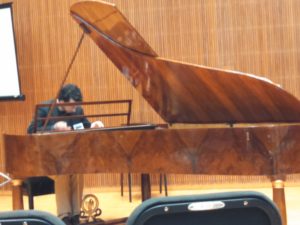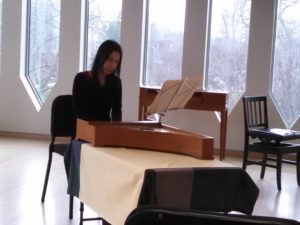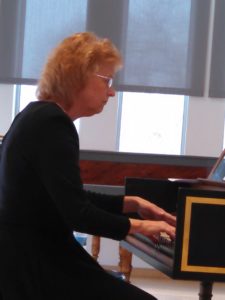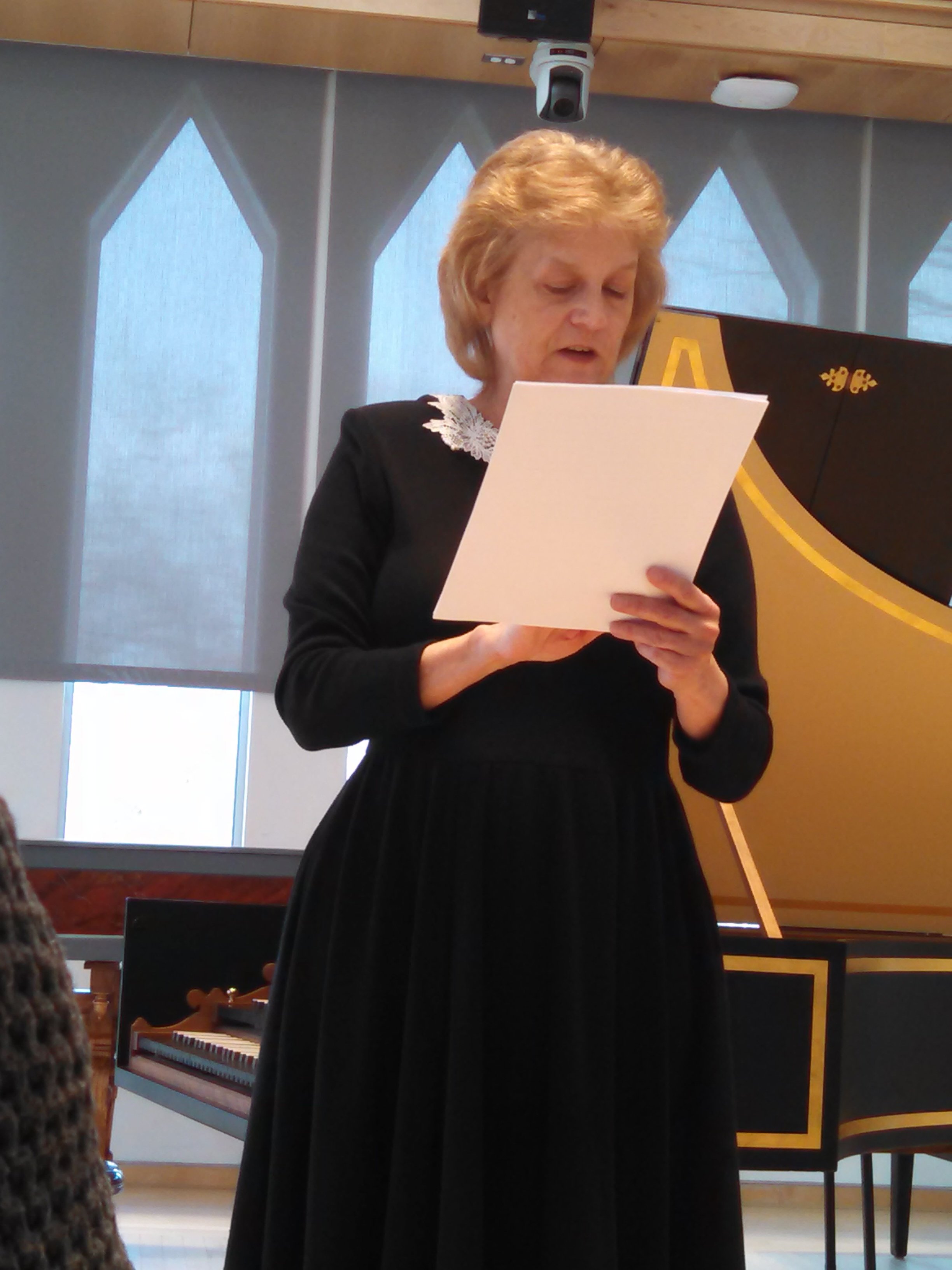By Ruta Bloomfield –
The Fifth Annual Conference of the Historical Keyboard Society of North America took place at Oberlin Conservatory in Ohio March 21-23, 2016. HKSNA is comprised of members who love and promote early keyboard instruments and the music written for them. Formed in 2012 by the merger of the Midwestern Historical Keyboard Society (MHKS) and the Southeastern Historical Keyboard Society (SEHKS), its members include instrument builders, players, teachers, and scholars, as well as many who merely love the looks and sounds of these beautiful instruments.
Attendees were treated to papers, recitals, and lecture-recitals. Breaks allowed for congenial conversation and visits to a display of harpsichords and clavichords, as well as CDs for sale. The conference banquet brought all together for a delicious meal combined with the HKSNA business meeting.
The theme for this year’s conference was “The Compleat Keyboardist: harpsichord, fortepiano, organ, clavichord, continuo.” Each of the three days successively moved back in time, the first highlighting the Classical and Romantic periods, the second the Baroque, and the last Renaissance and Medieval keyboard instruments and literature.

Each day also included special aural treats. For example, Chopin impromptus on the first day were played on two types of grand fortepianos. Robin Morace successively demonstrated the same passage on each instrument, illuminating the difference in sound between the English Broadwood and Viennese Zierer pianos. The former has a much larger and sustaining tone, close to that of a modern piano. The latter is much more subtle and less sustaining. Gentle nuance through rubato was needed.
On day two, we heard Dennis James play the glass armonica and the unusual orphica, a portable piano. Another aural revelation was hearing a lautenwerk in person. This gut-stringed harpsichord has a sound similar to a buff stop, but much richer since it is not muted. It was simply delightful.

The last day brought more sound delicacies. A mother and child muselar built by Ed Kottick was heard in two recitals. The Flemish muselar is a virginal with the keyboard positioned on the right. A warm, resonant sound results from the strings being plucked close to their center points. The “child” to this “mother” is an ottavino, a miniature virginal sounding an octave higher, tucked away on the left side of the instrument. The two keyboards can be played separately or placed one on top of the other. (Right: Oberlin student performing on an Ed Kottick mother and child muselar in Fairchild Chapel)

The last recital of the conference offered one final surprise. Satono Norizuki performed on a clavisimbalum, medieval ancestor of the harpsichord, built by Carl Rennoldson based on the earliest description extant by Henri Arnaut de Zwolle. Small enough to fit on a tabletop, the instrument has a surprisingly big sound. The nearby audience could not tell that the jacks lacked dampers.
The conference opened with papers on Mozart’s five-octave clavichord (Mario Aschauer) and his fortepiano (Robert Grohman). The rich keyboard culture of early Baltimore (Thomas Strange) and piano pedal notation (Andrea Keil) were explored, followed by a recital of CPE Bach sonatas on clavichord (Carol lei Breckenridge). A paper on solo reduction of a CPE concerto (Jay Krasnow) was succeeded by recitals on fortepiano of four-hand rondos (Stephanie Schmidt and Andrew Willis), and works by Norburt Burgmueller (Sally Renee Todd).
Next were papers on the piano method of Francesco Pollini (Leonardo Miucci) and Germanic Enlightenment feminist ideals (Laureen Witelaw). The afternoon continued with the aforementioned Chopin impromptus (Robin Morace), Schumann and Chopin (Marie Blair), and Chopin Mazurkas (Randall Love) on the Broadwood and Zierer grand fortepianos. A lecture-demonstration on the 18th century Dutch organ (Thomas Spacht) rounded out the afternoon.
The harpsichord made its first appearance on the second day of the conference which centered on the Baroque. Papers on basso continuo (Sonia Lee and Ka-Wai Yu; Therese de Goede) and improvisation (Feng-Shu Lee) were followed by a recital of remarkably inventive keyboard improvisation on three instruments: portative organ, clavichord, and harpsichord (Mark Janello). Hearing various Baroque guitar techniques juxtaposed by similar examples in Scarlatti sonatas was instructive (Nina Campbell, Michael Unger, Rodney Stucky).

Next came the recital for glass armonica and orphica (Dennis James). Music on the harpsichord shifted to the future with Baroque Rock from the 1960’s (Sara Gulgas), and recitals of selected contemporary composers (Elaine Funaro) and Stephen Dodgson (Andrew Collett), before going back to French suites by German composers (Max Yount). My own lecture-recital on performance decisions in J.S. Bach’s Goldberg Variations (Image at left) was succeeded by recitals comparing the A Minor preludes of Froberger and Louis Couperin on lautenwerk (Martha Folts) and featuring chaconne transcriptions (Aya Hamada).
The last day of the conference focused on early Baroque, Renaissance, and Medieval keyboard music and started with two recitals of music from England on the Kottick mother and child muselar (Beth Garfinkel; Oberlin students). Oberlin alumnus Larry Palmer recalled the impact of outstanding faculty on students over many decades.
Recitals on organ of early keyboard arrangements (Helen Skuggedal Reed) and by Scheidt on clavichord (Judith Conrad) were followed by papers on emotion in keyboard music from Frescobaldi to CPE Bach (Massimiliano Guido), intabulation in 16th-century Italy (Ian Pritchard), and tablature strategies in the Turin tablature (Alberto Macri). The afternoon wrapped up with a lecture-recital on the first keyboard tablature ever printed (Maria Luisa Baldassari) and the recital of music on clavisimbalum from the Codex Faenza 117 (Satono Norizuki).
Evening events at the conference included a Baroque and Classical chamber music concert performed by Oberlin faculty and friends, as well as harpsichord recitals by Jane Chapman, Hank Knox, and Catalina Vicens.
HKSNA also sponsors an international harpsichord performance competition for young performers (the Mae and Irving Jurow International Harpsichord Competition) and a composition competition, promoting new music for early keyboard instruments (the Aliénor International Harpsichord Composition Competition). This conference featured the semi-final and final rounds of the Jurow. Participants came from seven countries, and the sparkling play of Eunji Lee from Korea earned her the first-place award, with Baltimore native Patrick Merrill the runner up.
The next conference of the Historical Keyboard Society of North America will be held April 27-29, 2017 in Greenville, SC. For more information please visit historicalkeyboardsociety.org.
Ruta Bloomfield, D.M.A., is professor of music at The Master’s College in Santa Clarita, CA (rutabloomfield.com).
